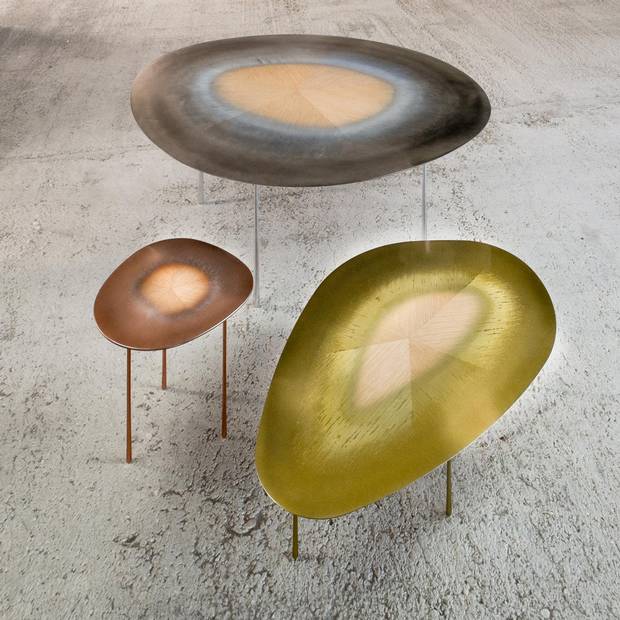Looking at the Echo tables, designed by Toronto-based architects Eiri Ota and Irene Gardpoit, the natural reaction might be to think: What is that made of? The razor-thin surfaces look, at first glance, like the off-cut of some celestial object that has crash-landed to Earth. Bits of a glittering meteor, say. Shimmering, metallic edges streak away, revealing the grain of something that looks ancient, like petrified remains.
Looking closer, though, the trick of the table is revealed. The materials are surprisingly prosaic: everyday metal and wood, melding together in a beautiful franken-composition.
"The tables aren't actually other worldly," Gardpoit explains. "The design itself is quite practical; the reason for using the wood and the metal is structural. Part of the wood being embedded in the metal makes for a stronger surface."

Each of the tables is made from a composite of wood that tapers out at the edges and blends into metal.
Making ordinary materials extraordinary is a preoccupation of the couple, and has been since they started their studio, UUfie, in Japan in 2009 (they later relocated to Toronto in 2013).
Their peacock chair is made from Corian, a common material used for kitchen counters. But rather than look like a giant butcher block, the seat gracefully fans out in a delicate, intricate lattice that is as supple as lace.
"We like seeing the new potential always," Ota says. "Even Corian, which people use for kitchen counter-tops." In their hands, what's solid dissolves into movement.
The proclivity can be seen in their architecture as well. A flagship they designed in Shanghai for Canadian fashion company Ports 1961 is made of glass blocks, but composed in such a way as to almost look diaphanous – like a cloud turning to mist.
The couple often looks to nature for inspiration – even if the results appear uncanny or intentionally contrarian. They designed a cabin in Ontario's Kawarthas region in 2013 that is strikingly clad in jet-black cedar and panels of mirror. It looks nothing like a typical cabin in the woods, but the idea is to connect strongly with the surroundings: the mirrors almost help the structure to disappear into a vision of trees.

The variations in the table top render shapes that are organic, allowing activity and motion around the table to be natural in any space. The tables are made of aluminum, copper, and brass, and feature contrasting gradients of colour as a result.
According to Ota, that contrarian nature helps heighten the appeal of his work. "Playing with contradictions helps bring people's curiosity higher," he says. "With that wooden table in front of you, people start to question what is it. They see both wood and metal. Both realities are very strong, both are real. When you don't have a boundary in between, you start not to know which is real. That's what we are thinking."
The couple's unique perspective has been derived in part by their international past. Ota was born in Paris and Gardpoit in Toronto, but they have lived and worked around the world (they met in Japan while collaborating on an apartment renovation, where "walls" were composed of lace curtains). "It's helped make our understanding of people and the way to live wider," Ota says. "It's given us new ways of communicating, and ideas of what to design."

